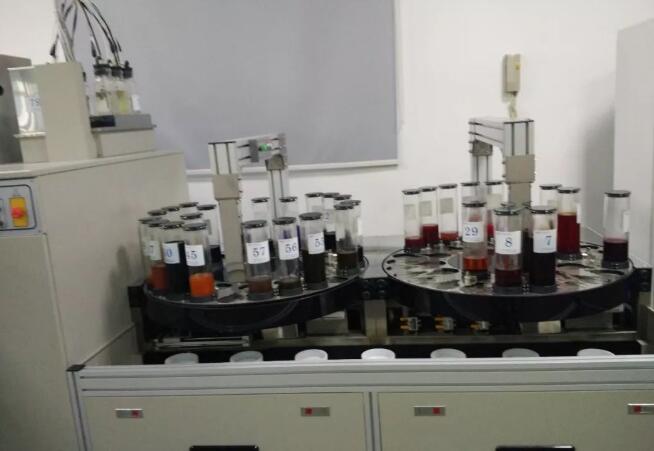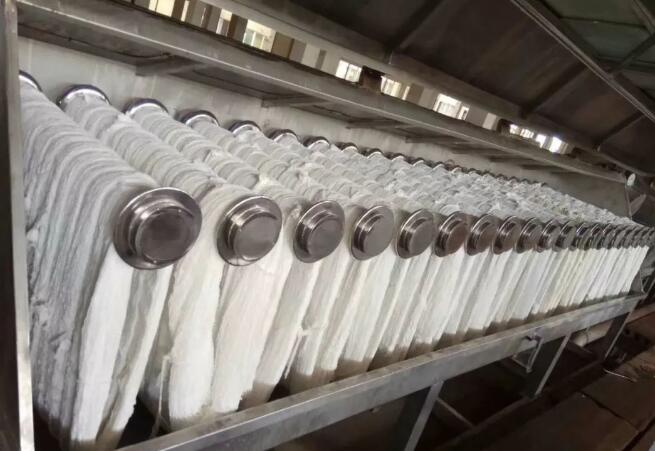Cored yarn includes 28S/2 rabbit hair, rabbit fleece and high elasticity. Its composition is mainly PTT/nylon/mercerized cotton or rayon. The main composition of double-curved is rayon/nylon. The dyestuffs used for corespun yarn dyeing are disperse, acid or neutral, and reactive dyestuffs respectively. And double twist mainly uses reactive and acid or neutral dyestuff. Due to the high washing fastness requirement of corespun yarn dyeing, acidic dyestuff is generally used as weak acid or metal complex dyestuff. Since the glass transition temperature of PTT fiber is much lower than that of polyester (PET) fiber, which is around 55℃, PTT fiber can be dyed deep at a temperature of 100 degrees, so disperse and acid can be dyed in the same bath.
In the process of workshop production, in order to save water, time and cost, dyeing can be done in one bath and two steps, i.e. dyeing active first and then adjusting the pH value of the dyeing solution (5-6), and then dyeing acidic and disperse. If the fastness requirement is not very high, drain after dyeing, wash a tank of80degree hot water, then into a tank of water on the soft can be, if the fastness requirement is high, for dark colors need to arrange 80-90 cooking (alkaline oil or DM diffusion powder), then wash a tank of hot water, then into the water soft out of the tank (Note: dark colors out of the tank before the fastness test must be done).
I. Corespun yarn process of proofing
1. Preparation before sampling
1.1 Dyestuff: Weigh the required disperse, acid, and active respectively, and make them in a certain proportion, generally 1/200 for the master batch, but since the proportion of acidic material used in corespun nylon is small, in order to improve the accuracy, the concentration of acidic material should be thinner: 1/400.

1.2 Weighing yarn: In order to ensure the proofing is not easy to occur color flower, the general proofing bath ratio is 15-20. So the general proofing with yarn weighing 5 grams, error ± 1%.
2. Sucking material (manually)
2.1 Sucking material first active, then acidic, plus the bath ratio of the required water. Add the salt and curing alkali required for the formula (below70degrees show alkaline, 75 degrees show acidic. (Dosage and substitute alkali almost the maximum amount of not more than 4 grams / liter).
2.2 Put in the weighed core yarn, shake well, and then put it into the 65 degree swinging proofing machine for 70 minutes. (Holding time depends on the reproducibility of workshop dyeing)
3, adjust the PH value: remove the conical bottle that has finished keeping temperature, drop a certain amount of glacial acetic acid (about 2g/l) into it, and adjust the PH value to 5-6.
4, absorb the dispersion: add the required disperse dyestuff and high uniformity to the dyeing solution with adjusted PH value. Then, add the dispersion to the dye solution.
5, put the dyeing solution with disperse material into the shaking well, put it into another shaking proofing machine, raise the temperature to 98 degrees and keep warm for 60 minutes.
6, Post-treatment: Take out the dyed yarn, wash it and put it into a cup, add the prepared alkaline oil and boil it for5minutes, take it out and wash it.
7, over soft to sample: put the washed yarn into the prepared soft oil for 1 minute and then take it out, dehydrate, blow dry, damp and then to sample.
Note: When proofing, three kinds of fibers should be set flat as much as possible. If you don&39;t flatten the yarn, the fabric will have horizontal stripes (color flower phenomenon). In addition, core yarn contains a variety of fibers, there is a certain selectivity to fluorescent whitening agent, some fluorescent whitening agent directness is good, fast coloring, easy to spend, not suitable for core yarn dyeing. Experience shows that 4BK is better for core yarn whitening and even dyeing.

II. Core yarn workshop dyeing process and its control
2.1 Water control of conventional spraying cylinder
The water ratio of the conventional spraying cylinder used now is about 1:6.
2.2 Process operation;
2.2.1 Yarn hanging: According to the amount of dyeing and the number of arms of this cylinder, calculate the average number of yarn hanging in each arm, and try to ensure that the number of yarn hanging in each arm is the same. When the quantity is small and there is a spare arm, the water inlet of the spare arm should be shut off to prevent pressure leakage.
2.2.2 Water inlet: Determine the water inlet according to the dyed color and bring the water in to the set water level.
2.2.3 Dyeing: At the same time of water feeding, water is fed into the secondary tank at the same time to dye the active and acidic materials together, ensuring enough time for dyeing (stirring for not less than 20 minutes) to ensure that the dyes are evenly mixed. At the same time, add the leveling agent and penetrating agent in the main tank, and run the water washing.
2.2.4 During the water washing operation of the main cylinder, check whether the yarn on the arm is running evenly, and if there is any pressure leakage or drum overlap, make sure to hook it evenly to prevent dyeing flowers.
2.2.5 Injection: After the dye in the secondary cylinder is evenly distributed and the yarn in the main cylinder is fully washed, open the filling pipe connection valve and press the filling button. Note: Inject material slowly, usually 10-20 minutes.
2.2.6 Add salt: If it is a dark color that is not easy to spend, salt can be run in the main cylinder all under before injection. But if it is light medium color or easy to spend color, it is recommended to add it in2-3times. Before adding salt, you must make sure that the dye runs in the main tank for not less than 20 minutes. The interval of salt addition should not be less than 10 minutes.
2.2.7: Adding alkali: When the salt is fully run, return the water to the secondary tank and add alkali and stir. After stirring evenly, inject quantitatively into the main cylinder, the general injection time is about 20 minutes.
2.2.8: Keep warm: after alkali is added, run for 20 minutes, then open the temperature control program, 1 degree per minute to 65 degrees to keep warm until the required time.
2.2.9: Take office to sample: stop the machine after keeping temperature, cut a bunch of yarn on a twisted yarn and wash it, cook a small cup to sample and leave the bottom.
2.2.10: Adjust PH value: When make sure the reactive dyeing is OK, add about 2g/l glacial acetic acid to start the machine and run it, adjust the PH value to 5-6. Then return the water to the secondary cylinder to chemical disperse dyestuff. And add dyeing auxiliaries needed to run in the main cylinder. This process try to bring down the temperature.
2.2.11, Injection: When ensure the disperse dyeing is well-distributed, inject it into the main cylinder within 10 minutes, and raise the temperature to 95 or 98 degrees after running for 10 minutes to keep warm.
2.2.12: Sample to color: After disperse dyeing, stop the machine without draining, cut a bunch of yarn with a knife to wash and boil a small cup to sample. If the color is accepted can go down to do post-processing, if not acceptable can add dispersion toning light.
2.2.13: Post-treatment: After the color is accepted, post-treatment according to the requirements, soft out of the tank.
Note: In fact, the active, acidic and disperse can be in one bath, but after inspection, it will cause the yarn disperse pollution and look unclean after adding them together. So it is recommended to separate the dispersion and other two materials.
Such as: black formula.
Active orange FR-G 0.3
Reactive dark red FR-R 0.27
Reactive black TS-D 2.6
60℃×60min
Acid black MSRL0.5
Dispersive black ECT300% 0.6
Salt 70g/l
Substitute base 3g/l
Acetic acid 1.5g/l
Alkaline oil 0.5g/l
DN powder 1g/l
White soft flake 0.6g/l
Smoothing agent 0.8g/l
2, for core yarn dyeing light color, it is not necessary to dye acid, single dyeing dispersion can be. Such as apricot color.
Reactive yellow 3RS 0.12
Reactive red 3BS 0.056
Reactive meta-cyan MSD 0.0255
60℃X45min
Dispersive yellow-brown S-4RL 0.038
Dispersive carnelian S-5BL 0.008
Dispersive dark blue HGL 0.01
95℃×30min
Anti-sedimentation agent WA 1g/l
High uniformity 2g/l
Acetic acid 1.5g/l
Salt 20g/l
Curing soda 1g/l
Alkaline oil 0.5g/l
White soft flake 0.8g/l
Smoothing agent 0.25g/l
3、Dyeing of duplex
The main components of duplex are nylon and rayon, both fibers are easy to color flowers in the dyeing process, so special attention should be paid during the dyeing process.
If using one bath method to dye double curves, it must be noted that
3.1. When acidic material and active material are made together, it must take enough time to ensure that the dyestuff is made open, and the material must be injected quantitatively for about20minutes when injecting. At the same time, because the acidic material is easy to adsorb at low temperature, we should make sure that we give enough circulation time after injecting the material to ensure that the yarn adsorbs the dye evenly. Ensure the even dyeing before adding the auxiliaries required for the active material.
3.2. When adding reactive dyeing auxiliaries, it is recommended to add them in several times or quantitatively to ensure the quality.
3.3.When adding acid to adjust PH value after active dyeing, as the temperature of main cylinder is 65 degrees, the temperature is high, adding acid may cause color flower, so you can lower the temperature to about 40 degrees when adding acid to adjust PH, if it is light color, it can be adjusted to neutral, add 1g/l ammonium sulfate dyeing. If it is deep and medium color, adjust PH to 5-6, then raise the temperature to dye acidic. The more acidic the material is, the faster it will be colored, and the less easy to dye evenly, so the amount of acid should be controlled.
3.4, if dyeing with two baths, drain the water after active dyeing, add acid to adjust PH, add acid leveling agent to run evenly, then add acid dyestuff as well (quantitative injection), ensure that the dyestuff adsorbs evenly before heating up (slow heating up).
4, Dyeing of nylon feather yarn.
For nylon feather yarn, light color can be dyed with disperse dyes, but pay attention to the sun fastness requirement, if the sun fastness requirement is high, it is recommended to use back acid dyes. The medium and dark colors are dyed with acid dyes.
Acid dyestuff dyed nylon feather yarn is easy to spend, in which the following points should be noted.
4.1, pay attention to hang the yarn evenly, including the weight of each arm and the number of strands.
4.2, the water should be fed to ensure that there is enough spraying force after starting the pump, and there should be no pumping, otherwise it is easy to spend.
4.3, Use hot water as much as possible to ensure that the dye is melted.
4.4, When injecting the material, inject the material quantitatively, do not fast.
4.5, to ensure that the dyestuff sufficient circulation time, adsorption uniformity, if there is unevenness, add more acid leveling agent in the cycle, until uniformity.
4.6, the rate of temperature rise should be slow (0.5-1 degree/min)
4.7, nylon feather yarn requires very soft handfeel, so pay attention to the handfeel before leaving the tank.
4.8, For light colored nylon feather yarn dyeing, no need to add acid, just add 1g/l ammonium sulfate and acid leveling agent.